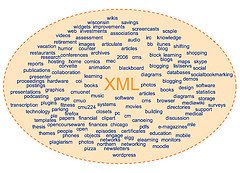 Yesterday I attended Laurie Damianos's discussion at the Boston KM Forum ("Tag Me -- Social Bookmarking in the Enterprise"). I had the good fortune of meeting Laurie first at last spring's Enterprise Search Summit.
Yesterday I attended Laurie Damianos's discussion at the Boston KM Forum ("Tag Me -- Social Bookmarking in the Enterprise"). I had the good fortune of meeting Laurie first at last spring's Enterprise Search Summit. I found that my number of questions for Laurie has increased since our last interview for the Provider Base piece set to go in the Nov/Dec Searcher. That increase is not because Laurie dodges good questions. It is inspired by the topic -- the richness of the subject itself.
To her credit as a speaker Laurie led an attentive and engaging group whose inputs were both numerous and broadly distributed. Here are some of the more engrossing threads of our dynamic session:
Life in Email --
The immediate remedy at Mitre began as the antidote to a ton of email sitting on some restricted fileserver archive. Increasing access points to content was the business case. A persuasive case was made that there was an over-reliance on 1:1 communication (email) whose knowledge might prove useful to others. Interestingly the Mitre approach includes bookmarking email message based on embedded links in the message.
Anatomy of a Tag --
Do the users make up their own terms? Apparently they have the choice between a pre-formed set of suggested tags or their own. The form includes the original bookmarker and others who've bookmarked their entries. Laurie refers to the comment feature as "a reverse blog."
Links to Nowhere --
Pointers need owners or the link goes stale. The broken link icon shows benefits of a link scan process that tests for 404 errors. Each owner is notified of the bookmarks they develop which they can choose to ignore, fix, or delete. Hovering over a padlock tells the user how to pick the lock (i.e. what password to use or group to contact). Users can mouse over faces and get lots of detail at a glance. When they leave the company the residual bookmarks are placed in separate account -- they can be copied for 90 days or let expire.
Social Tags (Supply) and Search Terms (Demand) --
The terms that bubble to the top of the results pages are not repesented in Mitre's subject taxonomy. According to Laurie the taxonomy is growing ... slowly. The search term is creating equivalencies between search terms and tags. Governance rules are in place to maintain the folksonomy so it is not altered by an intermediary. Laurie's team allows the differences to remain, not trying to normalize different forms of the same expression.
Expert Finders --
Administrators and gatekeepers had all the topic-related documents so they've been falsely deemed as experts. The same fiction occurs when a top-tagger is confused with being an expert in the subject they're tagging. There's no gaming of the system because there's no built-in incentive to compete head-on or outrank the next prolific tagger.
Social Bookmark Reporting --
There's a seven day window of the most recent popular tags. This breaks the dominance of librarian taggers as most prolific contributors. Tagging activity shows how users are related by interest area. Users can view bookmarks by department. Different sorting options including tags, bookmarks, bookmarks by department. Laurie noted some surprisingly bad taggers even as the firm's KM enablers or "knowledge stewards." Lynda Moulton noted that it takes mindset to do it consistently and effectively. People are getting it.
Tagging by the Numbers --
The system holds...
* 21,000 bookmarks
* 99,000 tags with 12.5K unique to the system (-- doesn't account for spelling and punctuation discrepancies)
* Average number of tags have doubled from 2.7 to 5.4
* The past three years the average is that bookmarks are 83% external
Performance Benchmarks --
According to Caterina Fake of Flickr 9-15% of population are contributors in social communities. This equates to 85-90% of users as lurkers. Fourteen percent of user population contributes at Mitre among those with access. Half of employees use the system.
Next Steps for Tagging --
Laurie mentioned an organization called LCC ("Language Computer Corporation") that examines semantic construction of document to relate tags to each other by generating "did-you-mean-this prompts" to the content provider. It also make recommendations to other users: "you need to talk to this person." It's based on common interests they're sharing beyond the recognition that their interests are shared.
Other Tagging Resources --
FURL caches the bookmarked resources. Users request feature but can't provide it internally because of copyright restrictions. Scuttle is easy to deploy and extend. Twine is another solution with an interesting social component. ConnectBeam and DogEar were also mentioned as self-contained tagging platforms.


No comments:
Post a Comment